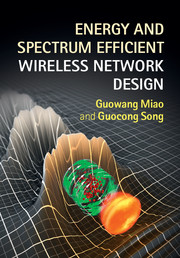Book contents
Preface
Published online by Cambridge University Press: 05 December 2014
Summary
This book provides a comprehensive introduction to the theory and practice of energy and spectrum efficient design for various types of wireless networks. The concepts and technologies are presented in a unified way for both centralized and distributed networks. The principles of the designs are stressed so that they can be applied in the broader context of wireless systems. The detailed derivations and proofs from first principles are provided. They are intended for the reader who desires a more in-depth understanding of the results. For the reader not interested in the detailed derivations, the concepts and theories are self contained and can be easily understood while skipping the derivations.
Energy and spectrum are two fundamental resources in wireless networks. A network design can always choose to optimize the utilization of one resource over the other. If one resource is redundant and the other is not, the design will need to optimize the network behavior towards better efficiency using that other resource. If both are adequate, then the system can be operated for the best user experience. If both are scarce, the design has to choose between them. Energy efficiency and spectrum efficiency are equally important and there is no clear advantage of one metric over the other. Which metric is more desired depends on network needs. This book presents a comprehensive yet rigorous discussion of the relationships between wireless channel state, energy efficiency, spectral efficiency, implementation, and network resource management in various wireless environments and their corresponding optimal designs.
The material in this book is structured into parallel discussions of energy and spectrum efficient designs, both of which are also discussed in parallell for centralized and distributed wireless networks. We hope this structure will facilitate the understanding of their similarities and distinctions.
The book is divided into four parts. In Part I, we introduce the basic concepts of wireless communications, e.g. wireless channel properties, performance metrics, conventional centralized and distributed radio resource management, that serve as the foundation to understand the book. The reader that is familiar with this background knowledge can skip this part and start from Part II directly. Part II introduces cross-layer designs for networks with central controllers and Part III for networks without central controllers. Both Parts II and III are focused on spectrum-efficient designs.
- Type
- Chapter
- Information
- Energy and Spectrum Efficient Wireless Network Design , pp. xv - xviPublisher: Cambridge University PressPrint publication year: 2014

